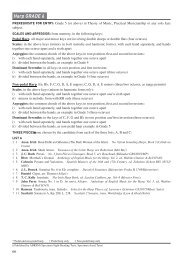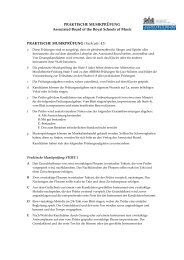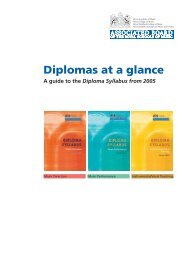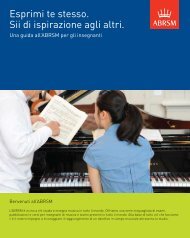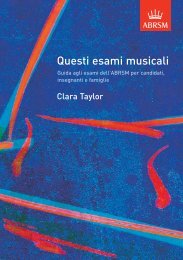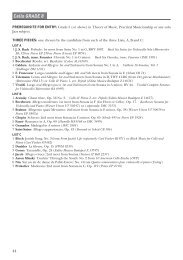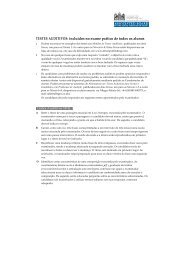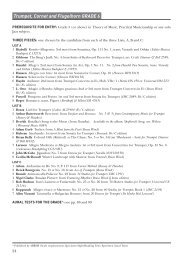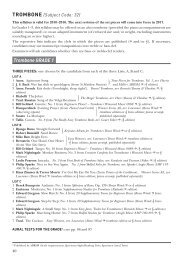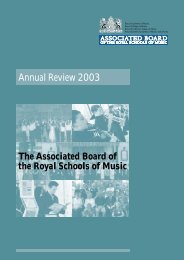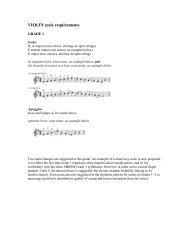Create successful ePaper yourself
Turn your PDF publications into a flip-book with our unique Google optimized e-Paper software.
Writing<br />
Programme<br />
Notes<br />
A guide for diploma candidates<br />
Nigel Scaife
Contents<br />
3 Introduction<br />
4 Overview<br />
4 Marking criteria<br />
5 Research<br />
7 Detailed advice<br />
7 Structure and content<br />
8 Prose style and format<br />
9 The use of technical language<br />
10 Presentation<br />
10 Headings and performer lists<br />
11 The use of quotation and plagiarism<br />
11 Notes for singers<br />
12 Practical help<br />
12 Top tips<br />
12 Test yourself<br />
13 Two examples of good <strong>programme</strong> <strong>notes</strong><br />
15 Conclusion<br />
© 2001 by The Associated Board of the Royal Schools of Music
Introduction<br />
This guide has been written to give music diploma candidates some advice to help with<br />
the research, preparation and <strong>writing</strong> of <strong>programme</strong> <strong>notes</strong> for Dip<strong>ABRSM</strong> and LRSM<br />
exams in Music Performance and Music Direction. The <strong>writing</strong> of <strong>programme</strong> <strong>notes</strong> is an<br />
important part of these exams and reflects the fact that most performers and directors are<br />
asked at some point to write <strong>programme</strong> <strong>notes</strong> for a recital or concert. It also allows<br />
examiners to assess how well you understand the musical and historical context of the<br />
repertoire you are performing and provides a starting point for discussion in the Viva<br />
Voce. It is important to remember, though, that the <strong>programme</strong> <strong>notes</strong> are reviewed by the<br />
examiner during the exam and do not receive a separate mark but contribute to the<br />
overall mark given to the Viva Voce.<br />
The importance of this task should not be underestimated, as informative and clearly<br />
presented <strong>notes</strong> can significantly enhance the listening experience of your audience.<br />
Many musicians find <strong>writing</strong> <strong>programme</strong> <strong>notes</strong> not just a powerful tool in increasing their<br />
audience’s appreciation and enjoyment of the concert, but also a useful way to clarify<br />
their thoughts about the music that they are to perform. In a similar way, music critics<br />
have often found <strong>writing</strong> them a valuable activity and it is no coincidence that some of<br />
the greatest writers on music have also written quantities of <strong>programme</strong> <strong>notes</strong>. The<br />
<strong>writing</strong> of what used to be called the ‘annotated <strong>programme</strong>’ has a history extending<br />
back to the eighteenth century, and old books of collected <strong>programme</strong> <strong>notes</strong> can be<br />
found in bookshops and libraries. Programme <strong>notes</strong> can also be found in music<br />
magazines, on CD inserts and record sleeves, as well as on the internet.<br />
The guide is in four sections:<br />
Overview<br />
This section briefly reiterates the main points made in the Diploma Syllabus about the<br />
basic form your <strong>programme</strong> <strong>notes</strong> should take and the marking criteria against which they<br />
will be assessed.<br />
Research<br />
This covers what you should do before you actually start <strong>writing</strong>. It is important that you<br />
give sufficient time to research and preparation. This will not only help you to write better<br />
<strong>notes</strong> but will also increase your background knowledge so that you are better prepared<br />
for the Viva Voce.<br />
Detailed advice<br />
Here there is more detailed guidance about the structure and content of your <strong>programme</strong><br />
<strong>notes</strong>, as well as some helpful advice about conventions of <strong>writing</strong> style and format.<br />
Practical help<br />
This includes some top tips and examples of good <strong>programme</strong> <strong>notes</strong> plus an opportunity<br />
for you to test yourself by spotting the good <strong>notes</strong> among the not so good!<br />
3
4<br />
Overview<br />
At Dip<strong>ABRSM</strong> level you are required to write <strong>programme</strong> <strong>notes</strong> of 1,100 words ( + -10%),<br />
while for LRSM the length is 1,800 words ( + -10%).<br />
Your <strong>programme</strong> <strong>notes</strong> should illuminate the <strong>programme</strong>/recital content in an interesting<br />
and relevant way. At Dip<strong>ABRSM</strong> level, imagine that you are <strong>writing</strong> for a generalist<br />
audience; at LRSM level you can angle them towards a more musically literate audience.<br />
Look at <strong>programme</strong> <strong>notes</strong> written for professional concerts and CDs to help you get an<br />
idea of what is required.<br />
You need to bring two copies of your <strong>programme</strong> <strong>notes</strong> along to the exam, which the<br />
examiners will retain. The examiners will refer to them as the exam takes place and may<br />
ask you questions about them.<br />
The Viva Voce is designed to enable you to show that the <strong>programme</strong> <strong>notes</strong> are definitely<br />
your own work by enlarging on and, where necessary, clarifying what you have written. It<br />
is also an opportunity for you to discuss your approach to putting together and matching<br />
the demands of the <strong>programme</strong>.<br />
For a full list of regulations please refer to the Diploma Syllabus.<br />
Marking criteria<br />
When <strong>writing</strong> your <strong>programme</strong> <strong>notes</strong>, bear in mind the criteria against which your work<br />
will be assessed.<br />
Dip<strong>ABRSM</strong><br />
LRSM<br />
Distinction Excellent. Candidate has Notes are pertinent and Notes are highly perceptive<br />
demonstrated exemplary persuasively written, with and persuasively written,<br />
standards in most areas thoroughly researched and with a high level of research<br />
examined.<br />
well-balanced commentary. and excellent organization<br />
of material.<br />
A high pass<br />
Notes provide an interesting Notes are pertinent and<br />
and relevant commentary on persuasively written. The<br />
the items performed. The material is well-organized<br />
material is well-organized<br />
and logically researched.<br />
and logically researched.<br />
A clear pass<br />
Pass<br />
Fail<br />
Very good. Candidate has<br />
demonstrated commendable<br />
standards in most areas<br />
examined and may have<br />
shown excellence in some.<br />
Good. Candidate has<br />
demonstrated a good overall<br />
standard in most areas<br />
examined.<br />
Candidate has shown<br />
competence in most areas<br />
examined and has satisfied<br />
the requirements for the<br />
award.<br />
Candidate has not satisfied<br />
the basic requirements for<br />
the award.<br />
Notes provide well-chosen<br />
detail on items performed,<br />
and firm evidence of helpful<br />
analysis based on sound<br />
research. Good presentation,<br />
structure, level of literacy<br />
and grammatical accuracy.<br />
Notes give background on<br />
items performed with some<br />
evidence of appropriate<br />
analysis and research. Acceptable<br />
level of presentation,<br />
literacy and accuracy,<br />
avoiding unexplained<br />
technical language.<br />
Notes fail to give<br />
background on items<br />
performed or sufficient<br />
evidence of appropriate<br />
analysis and research.<br />
Inadequate presentation<br />
and grammatically weak.<br />
Notes provide well-chosen,<br />
detail on items performed,<br />
and firm evidence of helpful<br />
analysis based on sound<br />
research. Good presentation,<br />
structure, level of literacy<br />
and grammatical accuracy.<br />
Notes give background on<br />
items performed with some<br />
evidence of appropriate<br />
analysis and research. Acceptable<br />
level of presentation,<br />
literacy and accuracy,<br />
avoiding unexplained<br />
technical language.<br />
Notes fail to give<br />
background on items<br />
performed or sufficient<br />
evidence of appropriate<br />
analysis and research.<br />
Inadequate presentation<br />
and grammatically weak.
Research<br />
Significantly, one word that appears in each of the criteria statements is ‘research’.<br />
Background research can provide fascinating insights into the composer’s intentions, and<br />
an understanding of the wider context of the music to be performed can sometimes quite<br />
radically affect its interpretation. The time you invest in research for <strong>programme</strong> note<br />
<strong>writing</strong> and the Viva Voce may well end up having a beneficial effect on the Section 1<br />
requirements of your diploma exam and is certainly time well spent. But just how should<br />
this process of research be approached?<br />
Structure, content and context of the music<br />
The first step is to consider how the piece works on its own terms by considering all<br />
aspects of its structure and content. This is something that generally happens<br />
automatically during the learning of the piece, but putting it into its wider context and<br />
relating it to the musical developments of its period demands a separate study. You may<br />
need to consider issues of performance practice. For example, was the piece originally<br />
written for a different instrument from the one on which you are performing?<br />
A description of the type of instrument for which the work was originally written,<br />
together with any conventions related to the style of performance on that instrument,<br />
may enhance the listener’s appreciation of the music. Reading a book such as The<br />
Historical Performance of Music by Colin Lawson and Robin Stowell (Cambridge University<br />
Press, 1999) may deepen your understanding of research into musical performance.<br />
Listen to other works by the composer and his contemporaries<br />
Listening to other works by the composer and to works of a similar kind is also a valuable<br />
activity. For example, it would be useful for a pianist at Dip<strong>ABRSM</strong> level preparing<br />
Chopin’s Nocturne in E to play through and listen to other nocturnes by Chopin. This will<br />
establish what the Nocturne in E has in common with the others, and those features that<br />
make it unique, as well as help with stylistic understanding and identification. The<br />
nocturnes of John Field (which gave Chopin the stimulus and inspiration to write his own)<br />
might also be investigated; you may wish to consider the differences between Chopin’s<br />
piano and the modern instrument; perhaps the view that Bellini was an important<br />
influence on Chopin’s melodic style might lead to an investigation of one of Bellini’s<br />
operas, and so on. These kinds of practical activities will help you to place the piece in a<br />
broad historical and musical context. But before that, you will need to learn that Field and<br />
Bellini are two composers worth researching in relation to Chopin’s nocturne. Your<br />
teacher may point you in the right direction, but you may also discover this kind of<br />
information through your own research of written sources.<br />
Background reading<br />
Written sources fall loosely into two categories – primary and secondary. Broadly<br />
speaking, primary sources are documents such as manuscripts and letters that have a<br />
direct bearing on the work, while secondary sources include other materials such as<br />
biographies, dictionaries and histories. General history books, such as Grout’s A History of<br />
Western Music (Norton, 2001 with C.V. Palisca), are useful in providing a broad overview<br />
of a musical period or composer. More detailed information can be found in The New<br />
Grove Dictionary of Music and Musicians, second edition (Macmillan, 2001) referred to<br />
as New Grove II, which is an invaluable and essential tool for the researcher. The<br />
bibliographies contained in Grove will lead to further information, such as biographies<br />
and books on specific works. If your library does not have a particular book that you are<br />
looking for, it is usually possible for the library to order it from elsewhere. As part<br />
of its diploma support material, the Associated Board publishes a list of reading<br />
suggestions which is continually updated and available on the Board’s website<br />
(www.abrsm.org/exams/diplomas). Candidates without internet access can request<br />
a copy from the Associated Board’s diploma office in London.<br />
Thematic catalogues, such as Köchel’s catalogue of the works of Mozart or Schmieder’s<br />
Bach-Werke-Verzeichnis, should not be regarded as just the domain of serious, academic<br />
researchers. While only specialist music libraries tend to have copies, if you can gain access<br />
5
6<br />
to them it is usually very helpful because entries for individual works often include a<br />
bibliography on that specific work – a terrific short-cut to the core material! Many<br />
scholarly and good quality editions of music contain introductions, written by the<br />
editor or a specialist, and these can also provide detailed information relevant to a<br />
<strong>programme</strong> note.<br />
Contact the publisher<br />
For works that are either fairly contemporary and about which little may have been<br />
written, or perhaps are less well known or infrequently performed, it may be a good idea<br />
to contact the publisher. Often publishers keep files of material relating to works in their<br />
catalogue which they are happy to share with interested parties.<br />
Use reliable, up-to-date sources<br />
It is vitally important to be critical of all sources of information. Try to use up-to-date<br />
books that are reliable and contain the results of serious scholarship. Much musical<br />
information on the internet is poorly presented and contains errors. Always double-check<br />
factual information using a reliable source. Similarly, some CD inserts are written by<br />
experts and are based on thorough historical study, while others are badly organised and<br />
misleading. While gathering information, take <strong>notes</strong> and keep a record of all the sources<br />
you use so that you can refer back to them at a later date if necessary. Keeping your work<br />
well organized will ensure that vital information is not forgotten or mislaid.<br />
Gathering together the appropriate materials is only the start. Research is not simply a<br />
matter of stringing together a group of relevant quotations, or paraphrasing a couple of<br />
writers. The information needs to be ordered, interpreted and personalised in the light of<br />
your own experience of the music. Facts will lead to ideas and conclusions should be<br />
drawn from the information gathered.
Detailed advice<br />
Structure and content<br />
Allow content to determine structure<br />
Many <strong>programme</strong> <strong>notes</strong> are written in three sections:<br />
● a brief introduction to the composer<br />
● a section about the work’s historical context and the circumstances surrounding<br />
its composition<br />
● a description of the work itself<br />
This may sometimes be the best way to present the information, but the structure of any<br />
<strong>programme</strong> note will be determined by its content. A different degree of emphasis will be<br />
given to the various kinds of information, such as historical, social, biographical, as well as<br />
musical and analytical, within each note.<br />
Historical background<br />
All <strong>programme</strong> <strong>notes</strong> need to provide a balance between background information and<br />
more musical information related to the specific work performed. Many <strong>programme</strong> <strong>notes</strong><br />
will briefly recount the circumstances of composition, including details of commission, the<br />
first performance of the work and, if useful, brief information on its publication.<br />
Don’t use too much technical language<br />
Unlike painting, music does not keep still while you study it and the concert-goer has<br />
only one chance of identifying important points in the performance. In attempting to<br />
describe in detail the actual progress of the music, the <strong>programme</strong> note writer risks losing<br />
communication with a majority of the audience through inappropriate use of technical<br />
language (see page 9). The <strong>programme</strong> note should therefore be an interesting,<br />
stimulating and relevant commentary on the items performed and not an anatomical<br />
breakdown of their structure. Sentences along the lines of ‘In the recapitulation, the<br />
chromatic second theme of the first subject group starts in the relative major and<br />
modulates through G minor...’ are inappropriate. Discussion of the progress of the music<br />
should be limited to generally recognizable features rather than the finer details of its<br />
inner workings. Most kinds of analysis tend in any case to make for fairly difficult reading<br />
and are more appropriately placed in educational textbooks and musicological essays<br />
aimed at a specialist readership.<br />
Avoid poetic description<br />
There is a danger in <strong>programme</strong> note <strong>writing</strong> that description is used as a substitute for<br />
analysis. While some descriptive terminology may be used to good effect, poetic or<br />
picturesque descriptions of musical events along the lines of ‘The fiery theme that had led<br />
to a series of blazing major chords in the exposition now leads to an air of resignation<br />
from which no spark of hope can rekindle the dying embers’ are generally inappropriate<br />
to an understanding of the music! The poet and music critic W. J. Turner amusingly<br />
identified two extremes of approach in his volume of essays Facing the Music: Reflections<br />
of a Music Critic (Bell, 1933):<br />
There are two diametrically opposite kinds of <strong>programme</strong> <strong>notes</strong> – the purely descriptive<br />
and the purely technical-analytical. In my opinion, both are equally objectionable and<br />
useless. The descriptive <strong>programme</strong> note offers great opportunities for bad writers and<br />
poor musicians to show what havoc they can make of English prose. The writers who<br />
describe symphonies as if they were sunsets or battles, or election conflicts between the<br />
good and evil parties in the Universe, are useless to everybody, and positively harmful to<br />
those who are seriously trying to understand the art of music. But those who eschew all<br />
descriptions of this sort and give merely a dry technical analysis are, in my opinion, just as<br />
remote from the useful function of the annotator and critic.<br />
7
8<br />
Keep the information relevant and interesting<br />
The main function of a <strong>programme</strong> note is to help the reader develop an understanding<br />
of the music. Relevant biographical and historical information is important in this process,<br />
especially when linked to the music’s conception. Placing the work against the background<br />
of what the composer set out to achieve is a good starting point. Topics such as the impact<br />
a particular work made on its earliest audiences and whether the work was written for a<br />
particular performer may also be of interest. Certainly those features of the work that<br />
make it unusual or particularly innovative should be discussed. Alternatively, if the<br />
composer was working within an established tradition, some well-chosen details of how<br />
the work reflects that tradition might contextualise the work in an interesting and helpful<br />
way. While it is important not to be afraid of telling the human story behind a piece of<br />
music, provided it is directly relevant, it is not appropriate to write long passages on the<br />
personal life and lifestyle of the composer. All biographical information should be directly<br />
linked to the music presented. It is the music itself that must form the main focus of<br />
attention. Crucially, writers should consider what the audience wants to read, not simply<br />
what they want to write about.<br />
Prose style and format<br />
Whilst poor grammar can be a reason for failure (see marking criteria, page 4) the most<br />
important aspect of your <strong>programme</strong> note is its content. The following advice will help<br />
you polish the presentational aspects of your <strong>programme</strong> <strong>notes</strong>.<br />
Programme <strong>notes</strong> should be written in clear and direct prose that informs and enlightens<br />
the reader. Clarity is essential. While avoiding subjectivity and the first person pronoun (‘in<br />
my opinion’ or ‘I like this because’), you should aim to be neither invisible nor too<br />
intrusive. The use of language and the principles of good <strong>writing</strong> can be found in many<br />
books on those subjects. Below are some general guidelines that focus on areas peculiar<br />
to <strong>writing</strong> about music. More detailed information can be found in Music in Words by<br />
Trevor Herbert (<strong>ABRSM</strong> Publishing, 2001).<br />
Use of capitals<br />
Capitals should be used for musical periods such as the Renaissance, but not adjectivally<br />
(e.g. romantic expression, galant style, or classical elegance). Capitals should also be used<br />
for adjectives derived from proper names (e.g. Mozartian), specific titles such as First Piano<br />
Concerto (but Beethoven’s piano concertos) as well as titles of movements such as Adagio<br />
or Rondo. Names of sonata-form sections usually do not require a capital.<br />
Use of italics<br />
Italics should be used for titles of books and musical works such as operas and symphonic<br />
poems, for dynamics and their abbreviations, and also for any foreign terms or short<br />
phrases which have not become adopted into the English language (assuming English is<br />
the familiar tongue of the writer). Hence, use italic for musical terms such as con sordino<br />
and lamentoso, but normal type for pizzicato, ostinato and legato. Use normal type with<br />
single quotation marks for titles of single songs, motets, madrigals, and similar works, and<br />
for nicknames applied to instrumental works (e.g. ‘Moonlight’ Sonata). If in doubt, refer<br />
to New Grove II.<br />
In general, keep punctuation to a minimum. Short sentences are often best.
The use of technical language<br />
Dip<strong>ABRSM</strong><br />
At Dip<strong>ABRSM</strong> level, you should write your <strong>programme</strong> <strong>notes</strong> for a general concert<br />
audience – that is, an audience of non-musicians who are interested in music and are fairly<br />
knowledgeable. If your <strong>programme</strong> contains standard repertoire works, the generalist<br />
audience will probably already know something about them and may have heard either<br />
live or recorded performances of them before. Writing about very well-known pieces may<br />
initially seem a daunting task (what more can there be left to say about Bach’s Cello Suites<br />
or Beethoven’s ‘Moonlight’ Sonata?). But the audience will still appreciate being<br />
reminded, or told for the first time, of the background to the pieces, the composers’<br />
intentions, and other relevant information about the works and what makes them<br />
popular. Some technical but universally common language may be helpful and necessary,<br />
but its meaning should always be clear. The following examples show the style of <strong>writing</strong><br />
you are aiming for at Dip<strong>ABRSM</strong> level:<br />
● The defining features of the chaconne are a triple metre and an ostinato (repeating) bass<br />
line, which often begins with a descending scale. The repeated bass line of this chaconne<br />
is simply a series of four descending <strong>notes</strong>, which can be heard very clearly in the<br />
introduction.<br />
● Like the majority of Scarlatti’s arias, ‘Ergiti, amor’ uses the ‘da capo’ aria form that<br />
dominated eighteenth-century Italian opera. It consists of three sections (ABA), in which<br />
the repeated A section is usually sung with additional ornamentation.<br />
● Towards the end of the movement there is the conventional cadenza passage which<br />
provides an opportunity for the performer to improvise using themes from the<br />
movement. The cadenza played today is not an improvisation, but has been written<br />
by the performer in a Mozartian style.<br />
● The composer now introduces a short bridge-passage, using the brass and woodwind in<br />
question-and-answer style. He ingeniously uses this section as a link from the agitated<br />
and dramatic first theme to the more flowing and lyrical second idea. The melody here<br />
is played by the lower woodwind, saxophones and French horns, creating a warm<br />
atmosphere, accompanied by rich harmonies in the trombones and basses.<br />
● The third movement is based on a Hebridean song and evokes the Scottish landscape.<br />
Whereas, in the version for full orchestra, the flute plays the melody, in this chamber<br />
arrangement it is given to the oboe. The harp plays an important accompanying role in<br />
this movement, helping to create a highly dreamlike atmosphere.<br />
LRSM<br />
At LRSM level, you need to discuss the musical content in more detail and with more<br />
technical language. Write as though your <strong>programme</strong> <strong>notes</strong> are going to be read by an<br />
intelligent, informed reader. Here are some examples:<br />
● The third variation combines the characteristic dotted rhythm of the main theme with a<br />
revision of the original melodic contour, now based on the dissonant interval of an<br />
augmented fourth – the ‘diabolus in musica’ (devil in music) of medieval music theory.<br />
While the basic binary (AB) structure of the theme is maintained, the second section is<br />
much extended with contrapuntal elaborations of the melodic material.<br />
● In the Adagio, effective use is made of many of the violin’s tone-colours, for example<br />
through the use of the mute and harmonics at the end of the piece which produce a pure<br />
and ringing sound. This contributes to one of the essential features of the composer’s style<br />
– his unique adaptation of French impressionism. The oriental-influenced harmonic and<br />
melodic language is in complete contrast to the previous movement, with its emphasis on<br />
tonal melody and conventional triadic harmony.<br />
9
10<br />
● The serene rondo theme of the finale is anchored to a deep pedal note and has the<br />
character of a folksong. The spacious layout of the movement allows for two episodes –<br />
easily discernible since the tension increases as each plunges into strident and energetic<br />
octave passages in minor keys – as well as a good deal of development besides. The rondo<br />
theme becomes the focus of the brilliant prestissimo coda in which long trills decorate the<br />
penultimate appearance, anticipating Beethoven’s most mature style of piano <strong>writing</strong>.<br />
● The interweaving contrapuntal lines contrast with chordal textures, particularly at the<br />
words ‘and the glory of the Lord’. Here, Handel often makes use of the hemiola, whereby<br />
a duple or two-time feel is superimposed on the 3/4 metre at the cadential points.<br />
● Hans Keller has suggested that C major is Britten’s ‘own key’, the significance of which for<br />
the composer lies in the fact that it ‘probably represents a state of naturalness’. At one<br />
level, the opening 54 bars do seem excessively economical and repetitive, but might it not<br />
be the case that Britten here is suggesting that the worship of God is indeed humankind’s<br />
natural state?<br />
Presentation<br />
You must present two copies of your <strong>programme</strong> <strong>notes</strong> to the examiners at the start of<br />
the exam. They should be either typed or printed in black, and the title page must contain<br />
the following information:<br />
● the full title of the diploma and, for performance diplomas, your instrument<br />
● the date of the exam<br />
● the word count (excluding title page)<br />
● the works in your <strong>programme</strong> in the order in which you are to perform them<br />
In addition, all pages must be consecutively numbered. Please remember that for the<br />
exam you must not identify your name anywhere on or inside your <strong>programme</strong> <strong>notes</strong>.<br />
You are not expected to cite sources of information in detail, but should refer the reader<br />
to the author’s name. It is not appropriate to include a bibliography, although you should<br />
be prepared to discuss your sources in the Viva Voce.<br />
Part of the challenge of <strong>writing</strong> good <strong>programme</strong> <strong>notes</strong> is to pare the text down to<br />
essentials and make sure that every word is important. It can be more difficult to write<br />
about a piece in a couple of paragraphs than it is to discuss it at length. Stick to the word<br />
limit which at Dip<strong>ABRSM</strong> level is 1,100 words ( + -10%) and at LRSM level 1,800 words ( + -10%).<br />
Don’t forget to include your declaration form with your <strong>programme</strong> <strong>notes</strong>. Details<br />
relating to this are to be found on the diploma entry form as well as at the Associated<br />
Board’s website (www.abrsm.org/exams/diplomas).<br />
Headings and performer lists<br />
There are various ways in which a work can be listed in a <strong>programme</strong> note. The heading<br />
should normally give a formal title with key, catalogue identifier (e.g. Op.3 or K.414)<br />
where appropriate, the composer’s name (including first name if it is a living composer or<br />
if there is more than one composer with that surname e.g. J.S. Bach), and the composer’s<br />
dates. Each movement or song should be listed. Below is one way in which this can be<br />
done, although there are other equally valid ways of doing it. The main thing is that<br />
there is consistency.
Sonata in C minor (‘Pathétique’), Op.13 Beethoven (1770–1827)<br />
Grave; Allegro di molto e con brio<br />
Adagio cantabile<br />
Rondo: Allegro<br />
For a movement with a title and separate tempo indication, use a colon after the<br />
title (e.g. Rondo: Allegro). If a movement has a major change of tempo in a clearly<br />
differentiated section, then a semicolon should be used (e.g. Grave; Allegro di molto<br />
e con brio).<br />
For vocal performances, individual songs are normally grouped together on the page<br />
whenever possible, to avoid unnecessary duplication of information and to alert the<br />
audience to appropriate places for applause.<br />
It is common to find within the <strong>programme</strong> a list of performers and their instruments or<br />
voices, together with brief biographies. Inclusion of this information is not a diploma<br />
requirement but will perhaps be appropriate for recitals which contain chamber music.<br />
How and where a list of performers is incorporated will depend upon the chamber<br />
repertoire performed and its extent and position within the recital. Short biographies are<br />
usually printed at the end of the <strong>programme</strong>, but there is considerable flexibility about<br />
how this information is presented. Biographical information on the performers should not<br />
be counted within the word allowance for each diploma.<br />
The use of quotation and plagiarism<br />
Keep quotations brief and credit the author<br />
Literary quotations from composers or commentators can sometimes throw light on<br />
important aspects of a piece. However, such quotations must be brief and fully identified<br />
as a quotation. Short quotations should be presented in the text within single quotation<br />
marks; longer quotations of more than two lines of prose should be indented without<br />
quotation marks. A full citation for the source of the quote is unnecessary, but candidates<br />
should refer the reader to the author’s name. It is not usually appropriate to include music<br />
quotations in <strong>programme</strong> <strong>notes</strong>.<br />
Always write in your own words<br />
It can be tempting to paraphrase or copy material from published collections of<br />
<strong>programme</strong> <strong>notes</strong> or from other sources such as CD inserts without acknowledgement<br />
of the author. While diploma candidates are encouraged to look at <strong>programme</strong> <strong>notes</strong><br />
written for professional concerts, as well as CDs, plagiarism must be avoided. (There is<br />
a note in the Diploma Syllabus about plagiarism and the necessity for all written<br />
submissions to be accompanied by a declaration form.) Some published <strong>programme</strong> <strong>notes</strong><br />
will be written in a particular style that would be difficult to pass off successfully as your<br />
own work, and will be familiar to the examiners, while others will be poorly written or<br />
inaccurate. Doing your own research and analysis will reap rewards as your enthusiasm<br />
and personal insight will communicate itself to the reader. It will usually be clear to the<br />
examiners during the course of the Viva Voce whether the work is your own or not.<br />
Notes for singers<br />
Programme <strong>notes</strong> should normally contain the texts of vocal music. When a translation is<br />
necessary, the text and its translation should be presented in facing columns to allow the<br />
reader to cross-refer and due credit should be given to the translator. The texts will not be<br />
counted towards the required number of words of the <strong>programme</strong> <strong>notes</strong>.<br />
Recitals of vocal music will normally contain more items than those in instrumental<br />
<strong>programme</strong>s. Singers are therefore not expected to provide as much detail in their<br />
<strong>programme</strong> <strong>notes</strong> as instrumentalists. However, they must still fulfil the marking criteria.<br />
11
12<br />
Practical help<br />
Top tips<br />
Read aloud<br />
Try reading your <strong>programme</strong> <strong>notes</strong> aloud. Sometimes a sentence that appears good on<br />
paper sounds convoluted, confusing or just plain boring when spoken.<br />
Practise your Viva Voce<br />
Have some practice sessions where the ‘examiner’ (perhaps your teacher) questions you<br />
and searches a little more deeply. The examiners will base many of their questions in the<br />
Viva Voce on the issues raised in your <strong>programme</strong> <strong>notes</strong>, so practise explaining your points<br />
and providing examples to support your responses. Getting lots of practice before the day<br />
will give you extra confidence in the exam.<br />
Be self-critical<br />
Ask yourself: Do the <strong>notes</strong> bring the music alive? Do they give the reader relevant<br />
information about the composer and the circumstances of composition? Do they provide<br />
an enriching insight into the music? Do they encourage the audience to listen? Will they<br />
stimulate, entertain and interest the audience? Will they increase enjoyment of the<br />
performance?<br />
Test yourself<br />
If you can spot the four examples of quality work in amongst the less useful material<br />
below, then you are well on the way to <strong>writing</strong> good <strong>programme</strong> <strong>notes</strong>! Turn to page 15<br />
for the answers.<br />
1 It is well worth noting that in contrast to the two movements sandwiching it, the laidback<br />
character of this movement, with its long hairpins and relaxed feel, is a bit like one<br />
of those nocturnes by the likes of Chopin.<br />
2 Exactly when, why and for whom Bach originally wrote his cello suites remains unknown.<br />
The earliest known source for them is a copy made about 1730 by Bach’s second wife<br />
Anna Magdalena, but they almost certainly date from his years (1717–23) at the court of<br />
Prince Leopold of Anhalt-Cöthen.<br />
3 In the first movement the four percussion instruments are used to create what the<br />
composer has described as a ‘spray’ of sound, with a soft attack and slow decay. In the solo<br />
clarinet part, groups of three or four pitches are used to highlight the specific qualities of<br />
timbre and register in the accompanying instruments, creating a fascinating dialogue<br />
between them.<br />
4 The trombone is always difficult to play with a rounded sound, owing to the<br />
predominantly straight tubing, and with such long melodic lines requiring a huge lung<br />
capacity, excellent breath control and a strong embouchure, this piece is very challenging<br />
and demands a totally secure and virtuosic technique.<br />
5 The model for Part 1 of Johann Sebastian Bach’s Das Wolhtemperirte Clavier was<br />
J.C.F. Fischer’s (1670 –1746) Ariadne musica, which contained twenty preludes and fugues<br />
in nineteen different keys, and which was reissued in 1715. Early versions of twelve of the<br />
preludes are found in the Clavierbüchlein for Wilhelm Friedmann Bach (Bach’s eldest<br />
and favourite son) of 1720. Part 2 dates from the 1740s: the manuscript made by Bach’s<br />
son-in-law, J.C. Altnickol, is dated 1744 but bears later amendments in Bach’s own hand<br />
(www.greatcomposers/german/keyboard).
6 It opens with a meno vivo melody which is developed and repeated before leading into a<br />
section which increases in speed as a sequence of flowing quavers descends through the<br />
range of the instrument to its bottom B flat. This is followed by a rubato section that<br />
gradually increases in intensity leading to the climax of the piece where a passage of quavers<br />
rises up dramatically to a high and sustained semibreve. A section for solo piano is heard<br />
before moving into the second main section of the piece where a new melismatic melody is<br />
developed, before the original melody is repeated leading us to the end of the movement.<br />
7 The Three Sonatas for Violin and Piano, opus 30, were composed in 1802 and published<br />
the following year. While the title page of the set implies a subordinate role for the violin<br />
in its wording (‘Three sonatas for the pianoforte with the accompaniment of a violin’),<br />
Beethoven treats the two instruments as equal partners throughout.<br />
8 In his article on the composer contained in Grove’s Dictionary (1954), Eric Blom wrote that<br />
Rachmaninov’s music ‘is well constructed and effective, but monotonous in texture, which<br />
consists in essence mainly of artificial and gushing tunes accompanied by a variety of<br />
figures derived from arpeggios’.<br />
9 I think that although this song explores the nature of the human condition in general<br />
terms, in my opinion it also expresses Schubert’s own individual sense of loneliness and I<br />
try to portray this in my interpretation.<br />
10 Although Ravel first began work on his Piano Trio in 1908, it was not completed until the<br />
summer of 1914. Despite the greater part of it having been composed under the<br />
emotional pressures generated by the crisis that led to the outbreak of the First World<br />
War, there is no trace of grim events in the music.<br />
Two examples of good <strong>programme</strong> <strong>notes</strong><br />
Sonata in E flat minor: 1.10.1905 Janáček (1854–1928)<br />
Presentiment: Con moto<br />
Death: Adagio<br />
Written ‘In memory of a worker bayonetted during the demonstrations calling for the<br />
university in Brno’ this sonata is prefaced by a brief prose poem by the composer:<br />
The white marble staircase of the House of Artists in Brno...<br />
A simple worker Frantiˇsek Pavlík falls, stained with blood...<br />
He came only to plead for a university... and was killed by cruel murderers.<br />
Deeply affected by this tragic event of October 1905, Janáček composed a piano sonata<br />
subtitled ‘A Street Scene’ which consisted at first of three single movements: Presentiment,<br />
Death and Death March. The only copy of the third movement was burnt by the composer in<br />
a moment of extreme self-criticism during the final rehearsal for the premiere. In desperation<br />
he even threw the remaining movements into a river, but the foresighted performer had<br />
by that time made a copy and in 1924 Janáček gave permission for its publication.<br />
The first movement, in sonata form, opens with a mournful theme which is starkly<br />
interrupted by a strident ostinato (repeating) motif. This motif is always connected to the<br />
main theme and in its diminutive version supplies the momentum for the development<br />
section. The second subject provides reflective calm in an otherwise tempestuous<br />
movement. It is likely that the composer was recalling the crowd scenes and events of the<br />
poem while <strong>writing</strong> this highly-charged music, which contains much anger and frustration.<br />
The dirge-like theme of the Adagio is directly related to the ostinato motif of the first<br />
movement and is characterised by avoidance of accents on the main metric beat. This<br />
imbues the music with the quality of Czech speech-rhythms, a subject Janáček studied<br />
with great interest.<br />
The piano <strong>writing</strong> has an idiosyncratic originality and an almost unidiomatic pianistic<br />
quality. Nevertheless, it is always richly expressive and passionately creative in its fervent<br />
poetry. This sonata is indeed, as Hans Hollander has put it, ‘a heroic epitaph in sound’.<br />
13
14<br />
La vie anterieure Duparc (1848–1933)<br />
[Accompanied by the text and a translation.]<br />
La vie anterieure was originally written in 1884 for voice and orchestra. It is a throughcomposed<br />
setting of a poem by Baudelaire, from Les fleurs du mal (1857), in which the<br />
poet recollects, with aching nostalgia and sadness, a wonderful former life in a distant<br />
country. This is beautifully reflected in Duparc’s setting which moves from passionate<br />
excitement in the middle section to intense sadness and introspection in the piano<br />
postlude. The composer responds with highly chromatic harmony (influenced by Wagner<br />
and Franck, his teacher) and long, flexible melodic lines that sensitively suggest the<br />
natural inflection and mood of the words.<br />
Many of the hallmarks of Duparc’s style are here, including the use of long-held pedal<br />
<strong>notes</strong> in the accompaniment (he uses a drone in the bass throughout the first stanza),<br />
rhythmic flexibility, subtle modulations, a recognition of the different tonal qualities<br />
within each vocal range and above all an intense lyricism. The piano part is not simply an<br />
accompaniment but eloquently interacts with the voice, with internal counterpoints and<br />
melodies of its own.
Conclusion<br />
The quality of your <strong>programme</strong> <strong>notes</strong> should reflect the quality aimed for in every other<br />
aspect of the diploma exam. Try to write <strong>programme</strong> <strong>notes</strong> that are interesting and<br />
relevant, and which demonstrate your knowledge and personal research. Informative and<br />
well-written <strong>programme</strong> <strong>notes</strong> will significantly enhance the listening experience of your<br />
audience, so the investment of time spent on their preparation will certainly pay<br />
dividends!<br />
Test yourself answers<br />
1 Uses inappropriate slang (sandwiching, laid-back, hairpins, the likes of).<br />
2 A good, informative comment.<br />
3 A good, analytical comment which usefully incorporates the composer’s own description<br />
of the music.<br />
4 Rather than discussing the music, the writer seems to be arrogantly suggesting that we<br />
will be impressed by a great trombone technique.<br />
5 Superficially ‘academic’ and rather pretentious. Uses too much irrelevant factual<br />
information, especially dates. Also, a website is not the place to establish facts.<br />
6 Boringly descriptive – this leads to that, before leading to this, and so on. Assumes the<br />
reader knows what the terms meno vivo, bottom B flat, rubato, quaver, semibreve and<br />
melismatic mean.<br />
7 Good, factual and relevant comment.<br />
8 Blom’s subjective comment, which damns Rachmaninov with faint praise, is of no<br />
relevance to today’s audience. The source is very dated and has now been superseded.<br />
9 Uses the first person pronoun, which could be avoided.<br />
10 Good background material which usefully contextualises the piece.<br />
15
Writing Programme Notes is intended as a guide for Music<br />
Performance and Music Direction diploma candidates and their<br />
teachers, although it is relevant to all those involved in <strong>writing</strong><br />
concert <strong>programme</strong>s. It contains practical advice and information<br />
on all aspects of the process, from background research to<br />
conventions of <strong>writing</strong> style and presentation.<br />
Nigel Scaife, DPhil (Oxon), MMus RCM, GRSM, studied the piano at<br />
the Royal College of Music and the University of California before<br />
completing a doctorate in musicology at Oxford University. He has<br />
wide experience as a performer, teacher and writer on music.<br />
As Syllabus Principal at the Associated Board he has been closely<br />
involved in the development of the Diploma Syllabus.<br />
24 Portland Place<br />
London W1B 1LU<br />
United Kingdom<br />
www.abrsm.org<br />
Registered Charity No. 292182<br />
WPN 04/2005



